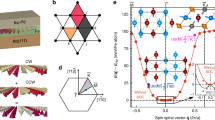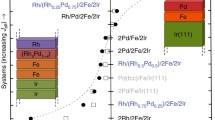Abstract
A Monte Carlo simulated-annealing algorithm was used to study the magnetic state in an in-plane helimagnet layer on triangular lattice that exchange couples to an underlayer with strong out-of-plane anisotropy. In the single helimagnet layer with in-plane anisotropy (K), the formation of labyrinthlike domains with local spin spirals, instead of parallel stripes, is favored, and these domains rapidly transform into dense skyrmion crystals with increasing interfacial exchange coupling (J′), equivalent to a virtual magnetic field, and finally evolve to an out-of-plane uniform state at large enough J′. Moreover, with increasing K, the skyrmion crystal state can vary from regular 6-nearest-neighboring circular skyrmion arrangement to irregular squeezed skyrmions with less than 6 nearest neighbors when the in-plane anisotropy energy is higher than the interfacial exchange energy as the skyrmion number is maximized. Finally, we demonstrated that the antiferromagnetic underlayer cannot induce skyrmions while the chirality inversion can be achieved on top of an out-of-plane magnetization underlayer with 180° domain walls, supporting the experimental findings in FeGe thin film. This compelling advantage offers a fertile playground for exploring emergent phenomena that arise from interfacing magnetic skyrmions with additional functionalities.
Similar content being viewed by others
References
A. Fert, N. Reyren, and V. Cros, Magnetic skyrmions: Advances in physics and potential applications, Nat. Rev. Mater. 2(7), 17031 (2017)
X. Zhang, Y. Zhou, K. Mee Song, T. E. Park, J. Xia, M. Ezawa, X. Liu, W. Zhao, G. Zhao, and S. Woo, Skyrmion-electronics: writing, deleting, reading and processing magnetic skyrmions toward spintronic applications, J. Phys.: Condens. Matter 32(14), 143001 (2020)
I. Dzyaloshinsky, A thermodynamic theory of “weak” ferromagnetism of antiferromagnetics, J. Phys. Chem. Solids 4(4), 241 (1958)
T. Moriya, Anisotropic superexchange interaction and weak ferromagnetism, Phys. Rev. 120(1), 91 (1960)
A. N. Bogdanov and U.K. Rößler, Chiral symmetry breaking in magnetic thin films and multilayers, Phys. Rev. Lett. 87(3), 037203 (2001)
A. Fert and P. M. Levy, Role of anisotropic exchange interactions in determining the properties of spin-glasses, Phys. Rev. Lett. 44(23), 1538 (1980)
A. Fert, Magnetic and transport properties of metallic multilayers, Mater. Sci. Forum 59–60, 439 (1991)
A. Fert, V. Cros, and J. Sampaio, Skyrmions on the track, Nat. Nanotechnol. 8(3), 152 (2013)
G. Chen, T. Ma, A. T. N’Diaye, H. Kwon, C. Won, Y. Wu, and A. K. Schmid, Tailoring the chirality of magnetic domain walls by interface engineering, Nat. Commun. 4(1), 2671 (2013)
G. Chen, A. T. N’Diaye, Y. Wu, and A. K. Schmid, Ternary superlattice boosting interface-stabilized magnetic chirality, Appl. Phys. Lett. 106(6), 062402 (2015)
G. Chen, A. T. N’Diaye, S. P. Kang, H. Y. Kwon, C. Won, Y. Wu, Z. Q. Qiu, and A. K. Schmid, Unlocking Bloch-type chirality in ultrathin magnets through uniaxial strain, Nat. Commun. 6(1), 6598 (2015)
M. Hoffmann, B. Zimmermann, G. P. Müller, D. Schürhoff, N. S. Kiselev, C. Melcher, and S. Blügel, Antiskyrmions stabilized at interfaces by anisotropic Dzyaloshinskii-Moriya interactions, Nat. Commun. 8(1), 308 (2017)
S. Banerjee, O. Erten, and M. Randeria, Ferromagnetic exchange, spin-orbit coupling and spiral magnetism at the LaAlO3/SrTiOO3 interface, Nat. Phys. 9(10), 626 (2013)
D. Cortés-Ortuño, N. Romming, M. Beg, K. von Bergmann, A. Kubetzka, O. Hovorka, H. Fangohr, and R. Wiesendanger, Nanoscale magnetic skyrmions and target states in confined geometries, Phys. Rev. B 99(21), 214408 (2019)
L. Sun, R. X. Cao, B. F. Miao, Z. Feng, B. You, D. Wu, W. Zhang, A. Hu, and H. F. Ding, Creating an artificial two-dimensional skyrmion crystal by nanopatterning, Phys. Rev. Lett. 110(16), 167201 (2013)
D. A. Gilbert, B. B. Maranville, A. L. Balk, B. J. Kirby, P. Fischer, D. T. Pierce, J. Unguris, J. A. Borchers, and K. Liu, Realization of ground-state artificial skyrmion lattices at room temperature, Nat. Commun. 6(1), 8462 (2015)
G. Chen, A. Mascaraque, A. T. N’Diaye, and A. K. Schmid, Room temperature skyrmion ground state stabilized through interlayer exchange coupling, Appl. Phys. Lett. 106(24), 242404 (2015)
A. K. Nandy, N. S. Kiselev, and S. Blügel, Interlayer exchange coupling: A general scheme turning chiral magnets into magnetic multilayers carrying atomic-scale skyrmions, Phys. Rev. Lett. 116(17), 177202 (2016)
M. N. Wilson, A. B. Butenko, A. N. Bogdanov, and T. L. Monchesky, Chiral skyrmions in cubic helimagnet films: The role of uniaxial anisotropy, Phys. Rev. B 89(9), 094411 (2014)
Y. Hu, X. Chi, X. Li, Y. Liu, and A. Du, Creation and annihilation of skyrmions in the frustrated magnets with competing exchange interactions, Sci. Rep. 7(1), 16079 (2017)
S. Z. Lin, A. Saxena, and C. D. Batista, Skyrmion fractionalization and merons in chiral magnets with easy-plane anisotropy, Phys. Rev. B 91(22), 224407 (2015)
M. Vousden, M. Albert, M. Beg, M. A. Bisotti, R. Carey, D. Chernyshenko, D. Cortés-Ortuño, W. Wang, O. Hovorka, C. H. Marrows, and H. Fangohr, Skyrmions in thin films with easy-plane magnetocrystalline anisotropy, Appl. Phys. Lett. 108(13), 132406 (2016)
S. Huang and C. Chien, Extended skyrmion phase in epitaxial FeGe (111) thin films, Phys. Rev. Lett. 108(26), 267201 (2012)
Y. Li, N. Kanazawa, X. Z. Yu, A. Tsukazaki, M. Kawasaki, M. Ichikawa, X. F. Jin, F. Kagawa, and Y. Tokura, Robust formation of skyrmions and topological Hall effect anomaly in epitaxial thin films of MnSi, Phys. Rev. Lett. 110(11), 117202 (2013)
P. Bruno, V. Dugaev, and M. Taillefumier, Topological Hall effect and Berry phase in magnetic nanostructures, Phys. Rev. Lett. 93(9), 096806 (2004)
Y. Tokunaga, X. Z. Yu, J. S. White, H. M. Rønnow, D. Morikawa, Y. Taguchi, and Y. Tokura, A new class of chiral materials hosting magnetic skyrmions beyond room temperature, Nat. Commun. 6(1), 7638 (2015)
J. Rowland, S. Banerjee, and M. Randeria, Skyrmions in chiral magnets with Rashba and Dresselhaus spin-orbit coupling, Phys. Rev. B 93(2), 020404 (2016)
S. Rohart and A. Thiaville, Skyrmion confinement in ultra-thin film nanostructures in the presence of Dzyaloshinskii-Moriya interaction, Phys. Rev. B 88(18), 184422 (2013)
B. Bian, G. Chen, Q. Zheng, J. Du, H. Lu, J. P. Liu, Y. Hu, and Z. Zhang, Self-assembly of CoPt magnetic nanoparticle arrays and its underlying forces, Small 14(34), 1801184 (2018)
W. Jiang, P. Upadhyaya, W. Zhang, G. Yu, M. B. Jungfleisch, F. Y. Fradin, J. E. Pearson, Y. Tserkovnyak, K. L. Wang, O. Heinonen, S. G. E. te Velthuis, and A. Hoffmann, Blowing magnetic skyrmion bubbles, Science 349(6245), 283 (2015)
B. Heim, T. F. R0nnow, S. V. Isakov, and M. Troyer, Quantum versus classical annealing of Ising spin glasses, Science 348(6231), 215 (2015)
R. Li, L. Yu, and Y. Hu, Spin-glass irreversibility temperature and magnetic stabilization in ferromagnet/spin-glass bilayers, Phys. Status Solidi Rapid Res. Lett. 13(6), 1900039 (2019)
X. Chi, R. Li, L. Yu, H. Kou, A. Du, Y. Liu, and Y. Hu, Spin glass properties mapped by coercivity in ferromagnet/spin glass bilayers, Nanotechnology 30(12), 125702 (2019)
X. D. Chi and Y. Hu, Modulation of skyrmion diameter in centrosymmetric frustrated magnet, Acta Physica Sinica 67, 137502 (2018)
N. Romming, A. Kubetzka, C. Hanneken, K. von Bergmann, and R. Wiesendanger, Field-dependent size and shape of single magnetic skyrmions, Phys. Rev. Lett. 114(17), 177203 (2015)
S. von Malottki, B. Dupé, P. F. Bessarab, A. Delin, and S. Heinze, Enhanced skyrmion stability due to exchange frustration, Sci. Rep. 7(1), 12299 (2017)
N. C. Koon, Calculations of exchange bias in thin films with ferromagnetic/antiferromagnetic interfaces, Phys. Rev. Lett. 78(25), 4865 (1997)
H. Du, W. Ning, M. Tian, and Y. Zhang, Field-driven evolution of chiral spin textures in a thin helimagnet nanodisk, Phys. Rev. B 87(1), 014401 (2013)
H. Du, R. Che, L. Kong, X. Zhao, C. Jin, C. Wang, J. Yang, W. Ning, R. Li, C. Jin, X. Chen, J. Zang, Y. Zhang, and M. Tian, Edge-mediated skyrmion chain and its collective dynamics in a confined geometry, Nat. Commun. 6(1), 8504 (2015)
X. Z. Yu, N. Kanazawa, Y. Onose, K. Kimoto, W. Z. Zhang, S. Ishiwata, Y. Matsui, and Y. Tokura, Near room-temperature formation of a skyrmion crystal in thin-films of the helimagnet FeGe, Nat. Mater. 10(2), 106 (2011)
Acknowledgements
The authors express their thanks to Dr. Gong Chen helping with this work. This work was financially supported by the National Natural Science Foundation of China (No. 11774045), the Joint Research Fund Liaoning-Shenyang National Laboratory for Materials Science (No. 20180510008), and the Fundamental Research Funds for Central Universities (No. N182410008-1).
Author information
Authors and Affiliations
Corresponding author
Rights and permissions
About this article
Cite this article
Sui, MX., Zhang, ZB., Chi, XD. et al. Dense skyrmion crystal stabilized through interfacial exchange coupling: Role of in-plane anisotropy. Front. Phys. 16, 23501 (2021). https://doi.org/10.1007/s11467-020-1000-6
Received:
Accepted:
Published:
DOI: https://doi.org/10.1007/s11467-020-1000-6




